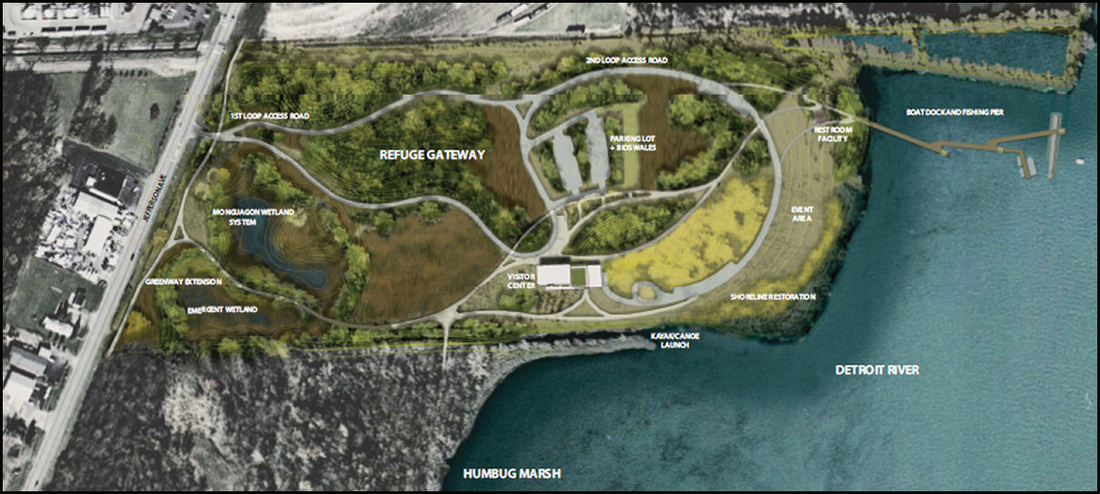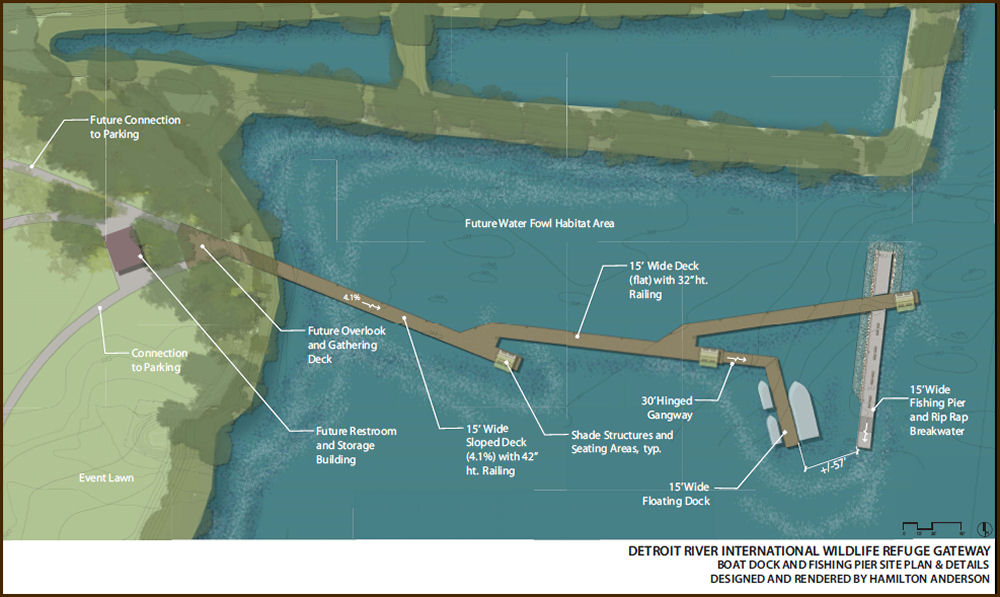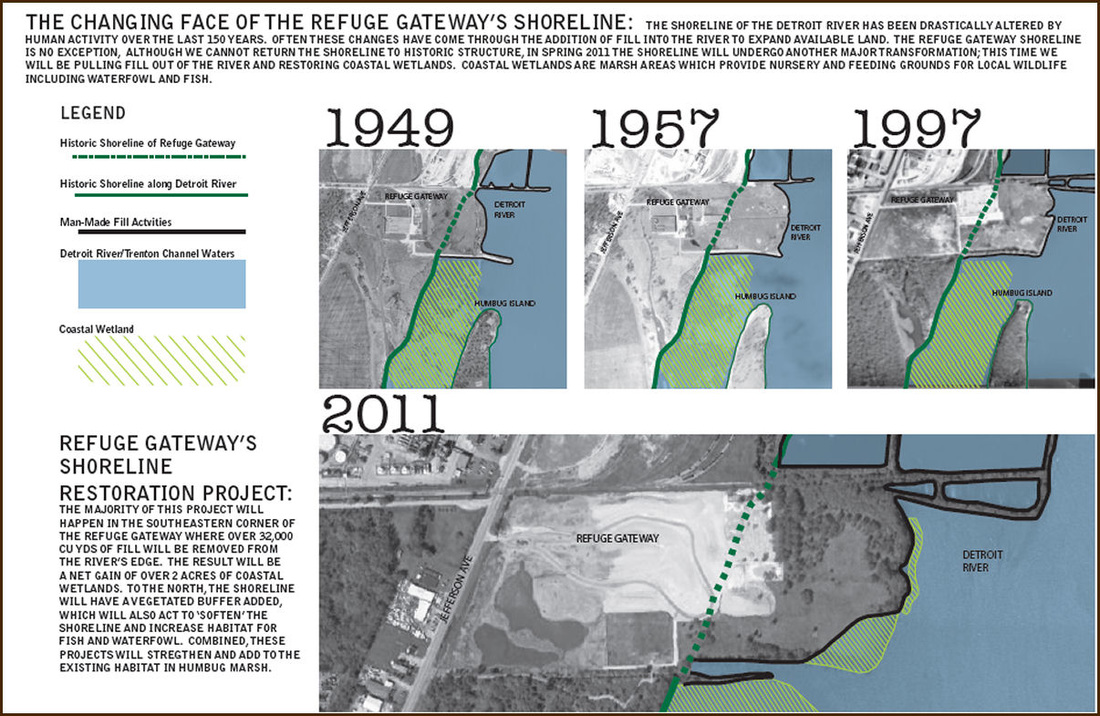We are fortunate, both as a club and as individuals, to be able to enjoy our proximity to the Detroit River International Wildlife Refuge (the first of it’s kind in North America). Their accomplishments over the last few years have been mind boggling and have not only changed/restored and improved the entire ecosystem of the area but have reclaimed and cleaned up the shorelines and rcleaned up numerous polluted areas and turned them into viable spawning areas. They have literally changed the face of the Detroit river and we now have sturgeon and whitefish spawning and Bald eagles nesting!!
This page will attempt to keep you up to date on the plans and progress that is being made on this great resource of ours!!
For a total overview and comprehensive look at the Detroit River International Wildlife Refuge, click HERE.

The Refuge Gateway is a former industrial property, known as the Trenton Chemical Facility, and was owned and operated by Chrysler for over 44 years. In 2002 Wayne County acquired the site. In 2004, through a group collaborative effort and lead by a design team from Hamilton Anderson, this Master Plan for the Refuge Gateway was adopted.
The Master Plan is a cohesive redesign of the Refuge Gateway property. The redesign focuses on sustainable practices that will improve wildlife habitat while creating a world-class visitor's experience. We are very happy to announce that some projects of the Master Plan have been executed. These include: daylighting the Monguagon drainage pipe and so creating the Monguagon Wetland System; the first loop of the access road leading into the Refuge Gateway and connecting to Humbug Marsh; the completion of a bridge, trail system, and education shelter into Humbug Marsh (from the Refuge Gateway) connecting the two sites into one experience; and the completion of a bike trail connecting the Refuge Gateway and Humbug Marsh to Lake Erie Metropark.

The boat dock and fishing pier will be located in the Trenton Channel of the Detroit River on the Refuge Gateway property. The Refuge Gateway is owned by Wayne County and is adjacent to the Humbug Marsh Unit of the DRIWR. The Refuge Gateway will become the future home of the visitor's center for the DRIWR.
Located just south of the warm water outflows of the DTE Trenton Channel Power Plant and adjacent to Humbug Marsh (the last remaining 1 mile of natural shoreline along the Detroit River U.S. shoreline), this location boasts a high diversity of fish species and is world famous as one of the best locations for walleye fishing. The location of the proposed fishing pier enables shore-based anglers to get the world-class fishing experience that is currently only available to those with access to a boat. The depth of water in this location is ideal for providing this high-quality fishing experience as well as for protecting the floating doc and school ship from wave action.
The boat dock and fishing pier will provide accessible, shore-based fishing opportunities on the Detroit River. The project, open to the public and anglers of all skill levels, includes a boardwalk, fishing pier, floating dock, restroom facilities, seating areas, shade structures, and interpretive signage.
Examples of universal design in our boat dock and fishing pier include: lower handrails to allow fishing by youth or those in a wheelchair; gentle slopes rather than stairs to allow accessibility for all types of mobility; and comfortable widths on the boat dock and fishing pier to encourage numerous visitors without limiting the ability for fishing. Areas accessible from the boardwalk are shallower waters, rich with panfish, providing an opportunity for less experienced and young family fishing, whereas the long length of the boardwalk allow for accessibility to deep water fishing, including walleye fishing, for more experienced fisherman. The boardwalk has been created with the priorities of universal design.

Universal design is a concept that encourages design to be accessible for all potential users, including youth, elderly, and disabled visitors to our facility. The boat dock and fishing pier is a story of many collaborating forces coming together to strengthen the available resources for the Downriver Community.
We are very happy to announce that this project was chosen to receive a half-million dollar grant from the Michigan Natural Resource Trust Fund (MNRTF). Wayne County generously matched the MNRTF grant bringing this project closer to the required budget. The staff at the Detroit River International Wildlife Refuge are actively working to find the rest of the funding sources needed for ground breaking on this exciting project.
From the beginning this project has been graciously supported by numerous collaborators. We greatly thank the Downriver Walleye Federation for their strong and continuing support of the boat dock and fishing pier. The Downriver Walleye Federation financially supported the conceptual design and also provided design guidance (to better understand the needs of fisherman) during public hearings for the boat dock and fishing pier.
Other important collaborators include: Wayne County Parks (owner of the Refuge Gateway site), US Fish and Wildlife Service (USFWS), Great Lakes Fishery Trust, Metropolitan Affairs Coalition, Wayne County Community College, Detroit Audubon, Michigan Sea Grant, Friends of the Detroit River, and the International Wildlife Refuge Alliance.
The Shoreline Restoration Project is an upcoming project at the Refuge Gateway in Trenton Michigan to begin in spring 2011. In an area where 97% of all coastal wetlands have been lost, this project will result in a net gain of 2.73 acres of restored coastal wetland along the Trenton Channel in the Detroit River.

The Shoreline Restoration Project includes two general construction activities along the Refuge Gateway shoreline. The first will take place on the southeastern corner of the Refuge Gateway, and will remove fill dirt from the edge of the property in order to recreate coastal wetlands. The work on the southeastern edge will grade the land to include small barrier islands and emergent wetland. The islands will protect the shoreline from wave and current action that can cause erosion. The islands will also help increase the diversity of habitat type available, through the changing elevations of the islands. At the top the islands will be drier and will support different vegetation than the sides. The islands will also be fitted with turtle ramps, encouraging turtles to use and nest in the area.
The second, less obvious construction activity, will create a vegetated buffer extending north along shoreline of the Refuge Gateway property. In restoration terms, the vegetative buffer and wetlands will work to "soften" the shoreline, helping to restore lost coastal wetland habitat that provide nursery and spawning grounds for our local wildlife.